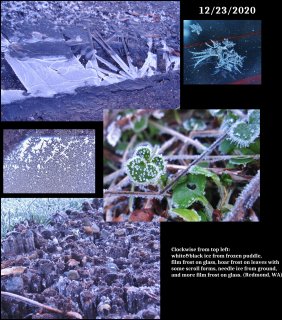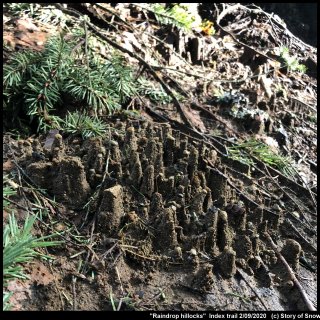Category: "Ground ice & patterns"
A Stroll on a Mildly Frosty Morning
December 23rd, 2020So far this winter, we've had few frost days in the Redmond, WA area. This morning was typical of the half-dozen or so: a very light dusting of hoar crystals on the roofs and grass. One cannot expect much, and yet I am rarely disappointed. Indeed, it is not until I get close to some icy thing do I notice anything interesting. Sometimes, I still don't notice until I've clicked a few closeups and then viewed on a large computer screen. Here's what I found on this morning's stroll:
The frozen puddle showed some curvy meniscus lines and some straight ice blades, which I've discussed before. The film frost is more mysterious still, but the main curvy pattern is due to the freezing of melt (not vapor deposition, though some of this does occur). The hoar frost shows some scroll crystals, which I recently addressed in an article (no mechanism had previously been argued, but we propose an explanation). See the crystals on the leaf at upper right for the best examples of scrolls, though the details are yet a bit too small. The needle ice is the phenomenon responsible for the crunchy dirt and pushes ice up from the bottom. The ground is warmer below the surface, and here the liquid migrates to the ice front, pushing it all skyward.
Anyway, that's it for this post. No detailed explanations of anything. If you would like to see such explanations, click on the appropriate category in the archives at the right side.
And here's hoping you have a nice, frosty Christmas, wherever you are-
--JN
Raindrop Hillocks and Ground Ice
February 16th, 2020Ever see these small centimeter-scale hillocks in dirt or sand, usually topped by a small pebble or twig? To me, they look like a miniature mountain landscape. A brief reflection on their appearance suggests erosion by raindrops: The drops fall down on and near the larger grain (e.g., pebble), pushing the smaller grains down, leaving the larger ones to stick up above. In this way, a scene of tiny hillocks emerge. I call them "raindrop hillocks".
Click on any image to enlarge it.
Soft, easily compactable soil seems necessary to their formation. Just toss some loose dirt into a pile, then come back after a heavy rain and you are likely to see something similar. But further reflection may present some difficulties. For example, some hillocks occur where the soil should not be loose. The above image presents one such case: here the soil was on a well used trail where the soil had long been compacted. Clearly such soil could not be so easily carved by tiny raindrops. The case pictured below is on a level sandbar after a river shifted course. Where did the sand go that was up near the peaks? It seems that the sand must have originally been very loose. How could this be?



